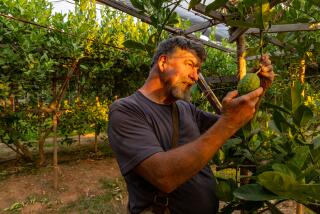Juicing Up the Pomegranate’s Image
- Share via
BAKERSFIELD — Dee Slayman knows the sad history of the pomegranate--the maligned, messy and misunderstood fruit that for 5,000 years has fought a losing battle of bad publicity.
In Greek mythology, Persephone was condemned to spend months in Hades every year for eating a handful of pomegranate seeds. And many biblical scholars believe that when Eve reached out to the tree of good and evil she snatched, not an apple, but . . . you guessed it.
“The pomegranate,” says Slayman, “is the fruit that sentenced man to eternal damnation.”
But the 47-year-old San Joaquin Valley farmer says “California’s strangest fruit” may be due for a bit of salvation in American grocery stores and at its dinner tables.
As the California grape did a decade ago, the pomegranate is enjoying its own, albeit lower-key, renaissance--an unlikely boost in reputation fueled by recent research showing the health benefits of the leathery-skinned fruit.
Two studies in Israel suggest that components of the fruit could be effective in fighting disease and slowing aging. The studies found that pomegranates contain high levels of chemicals that may help combat cancer and hardening of the arteries. With more antioxidants than even grapes, pomegranates may top even red wine in battling cholesterol, the studies concluded.
With a long history of use as a folk medicine in the Middle East, India and Asia, the pomegranate is now being employed as a sun block in skin products and as a treatment for the common cold. British researchers are exploring the possibility of making a nasal spray from its extract.
All of this is good news for Slayman, a third-generation farmer known as Kern County’s pomegranate king.
He hopes that Californians will look past the fruit’s stubborn skin and staining blood-colored juice to get to the tasty flesh inside.
“People don’t understand them,” he says. “They don’t know how to open them without wearing half the juice and ruining their clothes. They’re seen as the bastard child of California fruits.”
Slayman is among a handful of farmers to grow the fruit in California, the only state with the semiarid climate needed for the plants to thrive. But the crop represents only a fraction of the state’s massive agriculture industry. Local officials say 963 acres of pomegranates were planted in Kern County this year and 1,200 in Kings County.
Statewide, 4,500 acres produce a $10-million annual crop, according to the Pomegranate Council, which represents California growers.
“Everyone has fond memories of pomegranates from their childhood--red fingers and stained T-shirts--but modern mothers don’t want to put up with any of that,” said Bill Phillimore, executive vice president of Paramount Farming Co., the state’s largest pomegranate producer.
“We’re hoping that the new health studies will bring people around. I mean, why eat an apple when you can eat a pomegranate? It’s better for you.”
American researchers say they are encouraged by the Israeli studies.
“In many intensely colored fruits, the pigments have antioxidants,” said Barry Gehm, an endocrinologist at the Northwestern University medical school. “But we’re surprised by the initial results involving the pomegranate, and we think more work should be done.”
Slayman’s link to the fruit goes back two generations. His Lebanese grandfather began growing pomegranate trees in the 1920s--not for the edible fruit but to produce a dye. The business suffered its first domestic setback a few years later when a synthetic dye replaced the fruit’s runny red juices.
But the Slayman family business in Kern County refused to fold. The family began selling pomegranates as fresh fruit on the produce market. Slayman’s father, Mitchell, eventually became the nation’s biggest supplier of pomegranates before retiring in 1975, selling to Jewish communities, which revere the fruit as a sign of prosperity, on the East Coast.
He sold to the growing market in Japan, where the pomegranate is seen as a fertility fruit--a belief that continues to this day.
“Studies in Japan show that the fruit could help women’s menopausal symptoms,” said Carolyn Perdue, who works for an export firm that ships pomegranates to Asia.
Four years after his father retired, Slayman planted his first pomegranates, feeling drawn to the cultivation of the grapefruit-sized orbs that had been such a part of his childhood. He recalls being scolded by his mother for throwing the fruit at friends just to see it stain and ruin their clothes.
And he recalls how as a teen he refused his father’s request to help harvest the annual crop.
“I told him, ‘I’m so sick of pomegranates I could scream,’ ” Slayman recalls. “He literally knocked me out of my chair and told me that pomegranates put food on my table.”
They still do. Slayman devotes 500 acres of his farm--located in the southern corner of the San Joaquin Valley not far from the Grapevine--to growing pomegranates and apricots. Over time he has developed a vision for the fruit and recently he began marketing a line of pomegranate-based juices, vinegars and jellies, as well as potpourri, floral arrangements, Christmas wreaths and garlands.
But like any farmer, Slayman is a realist. He knows that public attitudes are often hard to change. He just doesn’t want to end up like the naive farmer in the story by the late author and Fresno native William Saroyan who loses a fortune in the pomegranate market.
“They’re certainly an acquired taste, but they’re in my blood,” Slayman says. “I don’t know, becoming a pomegranate grower just may be the biggest mistake of my life.”







